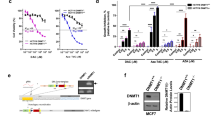Abstract
We examined the cytotoxicity and biochemical effects of the lipophilic antifol trimetrexate (TMQ) in two human colon carcinoma cell lines, SNU-C4 and NCI-H630, with different inherent sensitivity to TMQ. While a 24 h exposure to 0.1 microM TMQ inhibited cell growth by 50-60% in both cell lines, it did not reduce clonogenic survival. A 24 h exposure to 1 and 10 microM TMQ produced 42% and 50% lethality in C4 cells, but did not affect H630 cells. Dihydrofolate reductase (DHFR) and thymidylate synthase were quantitatively and qualitatively similar in both lines. During drug exposure, DHFR catalytic activity was inhibited by > or = 85% in both cell lines; in addition, the reduction in apparent free DHFR binding capacity (< or = 20% of control), depletion of dTTP, ATP and GTP pools and inhibition of [6-3H]deoxyuridine incorporation into DNA were similar in C4 and H630 cells. TMQ produced a more striking alteration of the pH step alkaline elution profile of newly synthesised DNA in C4 cells compared with 630 cells, however, indicating greater interference with DNA chain elongation or more extensive DNA damage. When TMQ was removed after a 24 h exposure to 0.1 microM, recovery of DHFR catalytic activity and apparent free DHFR binding sites was evident over the next 24-48 h in both cell lines. With 1 and 10 microM, however, persistent inhibition of DHFR was evident in C4 cells, whereas DHFR recovered in H630 cells. These data suggest that, although DHFR inhibition during TMQ exposure produced growth inhibition, DHFR catalytic activity 48 h after drug removal was a more accurate predictor of lethality in these two cell lines. Several factors appeared to influence the duration of DHFR inhibition after drug removal, including initial TMQ concentration, declining cytosolic TMQ levels after drug removal, the ability to acutely increase total DHFR content and the extent of TMQ-mediated DNA damage. The greater sensitivity of C4 cells to TMQ-associated lethality may be attributed to the greater extent of TMQ-mediated DNA damage and more prolonged duration of DHFR inhibition after drug exposure.
This is a preview of subscription content, access via your institution
Access options
Subscribe to this journal
Receive 24 print issues and online access
$259.00 per year
only $10.79 per issue
Buy this article
- Purchase on Springer Link
- Instant access to full article PDF
Prices may be subject to local taxes which are calculated during checkout
Similar content being viewed by others
Author information
Authors and Affiliations
Rights and permissions
About this article
Cite this article
Grem, J., Voeller, D., Geoffroy, F. et al. Determinants of trimetrexate lethality in human colon cancer cells. Br J Cancer 70, 1075–1084 (1994). https://doi.org/10.1038/bjc.1994.451
Issue Date:
DOI: https://doi.org/10.1038/bjc.1994.451
This article is cited by
-
Synthetic Lethal Interactions Prediction Based on Multiple Similarity Measures Fusion
Journal of Computer Science and Technology (2021)
-
From methotrexate to pemetrexed and beyond. A review of the pharmacodynamic and clinical properties of antifolates
Investigational New Drugs (2006)



